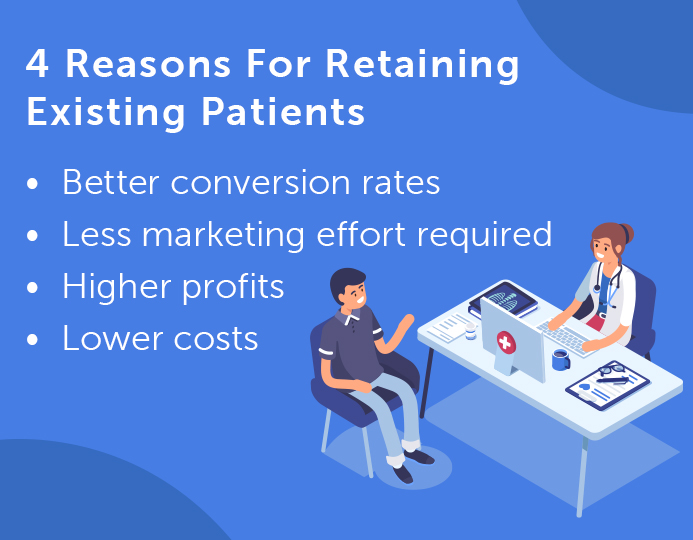14 Simple Ways to Ensure Patient Loyalty and Retention
Posted on
Patient loyalty is like sand in your hand. The more tightly you try to hold it, the more quickly it will trickle through your fingers.
Retaining patients has never been an easy nut to crack, as all medical practice owners and marketers are well-aware. There are a hundred things you could do right, and yet there is that one reason why the patient feels neglected and walks off.
Why has patient loyalty decreased?
There are several ways to explain this decline:
Failing to keep up with patient expectations: Declining patient loyalty has been an issue even for medical practices that invest heavily in improving services. Patients do not care that the service they are receiving is better than it was two months ago – they will use other “best-in-class” practices as a benchmark.
Failing patient loyalty programs: Many medical practices see the loyalty card as a shortcut to creating patient loyalty. Studies indicate that loyalty cards slash profit margins on existing patients, losing money rather than improving retention and loyalty.
Increased transparency: Smartphones and tablets have made the world more transparent. More than half of patients use their mobile devices to compare practices and practitioners, making it easy to find better “deals.”
Declining focus on the patient experience: When medical practices are divided into various departments, each department is responsible for different aspects of patient care. Often there is a lack of communication between departments.

Inconsistencies and lack of understanding across patient journey touchpoints can erode patient loyalty.

Lack of relevance to patients: If a patient is disloyal, he or she may say that the service was not relevant enough for them. This means that particular service did not stand out from the competition because not much thought was put into what role the brand should play in the patient’s life. The patient made a rational decision and chose your competitor rather than having any emotional attachment to your practice.
So, what influences patient loyalty?
The core of patient loyalty lies in how you interact with your existing and potential patients in your office. Here are some factors that affect patient retention and loyalty:
Lack of Personalized Attention
Patients are like koala bears: cute and harmless most of the time, but when annoyed, they do throw a tantrum.
Naturally, every patient expects personalized attention when he or she comes to your medical practice, especially if they are frequent visitors. To you, they might be the 1054th patient, but to them, they are important. Many medical practice owners and marketers fail to create a personal relationship with patients, making them feel as if they might not be valued members which, in turn, results in loss of patient loyalty.
Website Issues
A slow and inefficient website is one of the biggest turn-offs for patients. Server errors, hazy displays and lack of relevant content can drive a patient away from your website. These basic glitches can lead to loss of trust and, therefore, to loss of patient loyalty.

Insufficient Communication
Two-way communication makes for happy patients. Lack of clear and transparent conversations ends up frustrating patients and can lead to misunderstandings. Your patients will appreciate the free flow of information, good or bad, as long as they are in the loop.
The tone of communication is also an essential factor. Many patients have stopped visiting a medical practitioner because the support was poorly handled. Irrespective of how busy you are, take the time to listen to your patients and provide helpful advice about their problem and make sure that your staff does the same.
Falling Short of Patients’ Expectations
As patients start visiting your medical practice more frequently, their expectations start rising. This applies to the entire patient experience, including their virtual interaction with your staff as well as any physical communication that might occur.
When patients start feeling like a privileged member of your practice, you need to keep up your end of the deal. It is a common complaint among disillusioned patients that the service they receive now is not as fantastic as it used to be earlier. It is essential to avoid this decline in opinion, as it may harm patient loyalty and retention.
Staff Troubles
To quite a lot of medical practice owners with a non-medical background, back-end management is an intimidating task. It can be challenging to keep an eye on and understand all of the aspects of patient care.
A disorganized team can lead to you missing emails and appointment requests from patients or replying late to their problems, which is detrimental to your practice. Maintaining a clean website, in addition to other back-end processes, is a must for retaining patients.
Patients can nitpick about the information they see or do not see on your website. Given the number of fraudulent websites today, potential patients are not about to trust any healthcare website. In such cases, make sure your contact information is absolutely correct. One incorrect detail and you will be at the verge of losing patients.

Strategies that help retain patients
So, do you have any strategies for retaining patients? Not every suggestion or plan that you read online will be a good fit for your medical practice. Standard methods such as an active referral system, online visibility, SEO tactics, supportive staff and your commitment will ensure your success at retaining patients. Here are some of the basic, but effective, patient retention strategies to consider:
1. Inform patients about their next appointment: Make sure your patients are told the date and time of their next appointment and encouraged to return. While this may not seem vital, it is one of the most common causes of patients not coming back for further treatment. When your patients come for their first appointment, show them a personalized calendar with a treatment schedule that is tailored just for them. A customized calendar will convince your patients of your commitment and the importance of their next visit. Before they leave your office, your staff should give them a schedule that shows their next appointment date. You must train your employees to emphasize the next appointment when the patients are leaving your office.

2. Follow up after the appointment: After patients leave your office, be sure to send an email or call them to ensure they are following all the instructions. It is a good idea to show them you are interested in their well-being and recovery. You can also consider keeping patients up-to-date on the progress of their treatment.
3. Focus on each patient: Be respectful and tolerant while listening to patients’ concerns and myths about their illness. Your patients will only feel connected to you if you are listening to their worries. During an appointment, ask about their lifestyle, habits, sleep patterns, etc. Sometimes patients do not realize what may be affecting their health and how to fix it. As you guide them through the rough spots, they become more confident and encouraged.
4. Send out satisfaction surveys: Sending satisfaction surveys to your patients will help you see whether or not your treatment is having a positive impact on their well-being. Through these surveys, you patients may express their positive and negative experiences. Such surveys give you the opportunity to re-examine your strategy and change the aspects that aren’t yielding positive results. According to the Medical Group Management Association, nearly 80 percent of “better-performing” practices are using patient satisfaction surveys.
5. Simplify billing process: Simplifying payment is another way to increase patient retention. This is because patients will be more likely to come back to your practice if billing is transparent and straightforward. You do not have to overhaul the entire process. To begin with, you can ensure bills are written in clear and easy-to-understand language, minimize medical jargon, outline multiple payment options, have easy-to-locate contact information and provide maximum transparency in itemized statements.

6. Build personal relationships:
You should try to develop and maintain positive relationships with your patients. Simple gestures, such as ensuring that your staff is courteous, and patients were offered water when they arrived at your practice, go a long way in building a lifelong bond. You should train your employees to walk each patient through their appointment with helpful instructions, preparing for a lab test or checking out.
7. Promote patient engagement: Patients are important stakeholders in their healthcare and can provide valuable input for improving the quality of your service. Therefore, you must encourage them to make choices about their treatment plans and keep them informed of the latest healthcare options.
8. Educate patients: Educated and informed patients are usually the most pleasant ones. If your patients are happy with the quality of your service, they will return to complete their treatment. Many patients derive satisfaction from learning about their illness. They want you to tell them all you know about their illness and the further course of action.
9. Adopt flexible working hours: To attract more patients to your practice, you may have to make a few adjustments to your work schedule. If you listen to the reasons why your patients miss their follow-up appointments, you will learn that the biggest reason is their inability to arrive at your office at the set time for their treatment.
10. Manage your reputation: Reputation marketing produces steady results, whether online or offline. The majority of patients who search online for local physicians are more likely to see a directory review rather than your practice website. Also, most patients who want to come to your office will trust online reviews about your practice more than a referral from a satisfied patient. Therefore, promoting your reputation will make the community see you as a trusted medical practitioner.
11. Be empathetic: This is a very effective way to improve patient retention. Try to put yourself in your patient’s shoes and think like one, from the first contact on the phone until the patient leaves your office after treatment. During this role-playing exercise, be as critical and as observant as possible. Your role playing should cover welcome greetings from your front desk, experiences in the waiting room, interactions in the exam room and contact with the billing department.
12. Motivate your staff: The secret behind a winning team is a mix of people working hard toward one common goal. Patient retention has a lot to do with your staff and their attitude. When hiring, pay attention to the best combination of polite, efficient, professional, pleasant and optimistic staff.
13. Tactfully handle upset patients: When you notice an angry patient at your office, try to be calm, polite and empathetic. It might be a good idea to ask how their day is going and if there is anything you can do to make them feel better. A little sympathy can make someone’s day.
14. Handle negative reviews calmly: Even the best medical practices receive negative feedback. If your practice receives negative feedback, it is best to handle it promptly and professionally. Thank the reviewer for the feedback and address his/her concerns. Even if you cannot resolve the issue, make the patient feel heard and apologize for the unpleasant experience at your office.

Conclusion
Comfort leads to satisfaction, and patient satisfaction leads to retention. Learn how Practice Builders can help your practice improve patient satisfaction and retention. We have the knowledge and expertise you need to take patient retention to the next level. Contact us to learn more about our patient retention strategies.

 Why Good communication Matters in Healthcare
Why Good communication Matters in Healthcare De-Escalation Tips for Handling Aggressive Patient..
De-Escalation Tips for Handling Aggressive Patient.. Reaching The Right Audience Through Target Marketi..
Reaching The Right Audience Through Target Marketi..